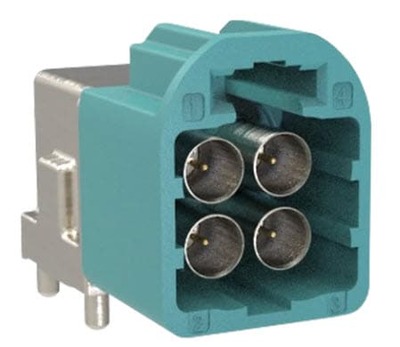AMRs in warehouse and industrial environments

Autonomous mobile robots (AMRs) are programmed to operate successfully within their surroundings. Amphenol RF is helping to enable autonomous mobile robots (AMRs) to navigate warehouse and industrial environments successfully, without the fear of bumping into things.
Motion and context
Autonomous mobile robots (AMRs) are finding increasing adoption in warehouse and industrial environments. They are reliable, round-the-clock, self-directed assets used to move and manage the flow of materials and products, plus work alongside people within these application contexts. AMRs can perform repetitive, complex, heavy, and potentially dangerous tasks efficiently and successfully.
In order to move, robots must incorporate a variety of sensors to collect data about their environment. They can have ‘sight’ by a sense of vision often achieved through cameras. Moving robots may use time-of-flight or infrared sensors to tell them of approaching objects and whether they may need to make a course correction change to avoid a possible collision. They can also often employ or detect auditory signals that give them information about their surroundings. They may utilise field-programmable gate arrays (FPGAs) and microcontrollers (MCUs) to process this information and turn it into executable decisions.
Autonomy
Aided by new technologies, including artificial intelligence (AI) and machine learning (ML), AMRs can ‘learn’ how to navigate to maximise productivity. When AMRs experience unexpected contexts, they can adapt and adjust. Self-correcting their course and navigating any potential obstacles without being impeded. This technology gives them autonomy.
Autonomy means they can operate with a degree of ‘self-legislation’ or ‘self-governance.’ This autonomy enables them to work independently of external operators. Their programming is such that they can self-govern their decision-making to optimise their performance to stated objectives constantly. Programming includes making them coherent to themselves to assess and prioritise what are considered higher- and lower-order responses. Sensing, processing, and AI combine to make them responsive to reasons, meaning they can see contextual clues and respond with reason. ML, a subset of AI, uses algorithms and places them into structural descriptions based on data examples. ML enables the robot to ‘learn,’ making it responsive to reasoning allowing its autonomous motion. Responsive reasoning will enable them to act and function independently of human interface.
Amphenol RF
Amphenol RF is a division of Amphenol Corporation, and is the world’s largest manufacturer of coaxial interconnect products for RF, microwave, and data transmission applications. As a leader in enabling next-generation technology, Amphenol RF is constantly supporting global advancements in connectivity. Amphenol RF is committed to providing solutions for autonomous mobile robots in warehouse and industrial environments.
An excellent example of this are the Amphenol RF AUTOMATE Type A Mini-FAKRA connectors (Figure 1). These subminiature version B (SMB) coaxial RF connectors feature a space-conscious, high-performance interface. This makes them well-suited for the next generation of autonomous vehicles and robotic applications. This series supports up to 20 Gbps data transmission and reduces installation space requirements by 80% compared with standard FAKRA (Fachkreis Automobil, a German standard) products. Typical applications include 360° surround-view cameras, autonomous vehicles, and AMRs.

AMRs often successfully employ Amphenol RF AMC4 RA to TNC/RP-TNC Jack IP67 cable assemblies. These are right-angle plugs to TNC (Threaded Neill–Concelman) and RP (Reverse Polarity)-TNC IP67 straight front mount bulkhead jack cable assemblies (Figure 2). These cable assemblies are available in a 1.13 mm micro-cable type and various cable lengths up to 300 mm. The AMC4 RA to TNC/RP-TNC cable assemblies are offered with gold contact plating with brass and phosphor bronze contact materials. The cable assemblies feature a 50Ω impedance and 6 GHz maximum frequency.

Conclusion
Before robots can become smart enough to move efficiently and work independently among other machines and people, they must be taught and have the ability to learn naturally from their surroundings. Like with infants, this process to move autonomously safely from one spot to another often involves baby steps — rarely does it happen immediately. Amphenol is engineering technology to help robots make sense of their surroundings and make intelligent connections to move about, freely on their own. You can follow their progress by watching the Amphenol Plugged In Video Series where we discuss this and other topics and key products that demand more convenience, mobility, power, and speed.
Seamless modular I/O integration
For seamless modular I/O integration, WAGO controllers combine with WAGO's I/O System 750 to...
LAPP Australia introduces ultra-reliable Wieland Electric wipos power supplies to Australia
Power supplies perform a central function in the control cabinet, so a robust and proven design...
Drive the future of transportation with SCHURTER
SCHURTER offers solutions for various applications in the automotive industry: our products...








